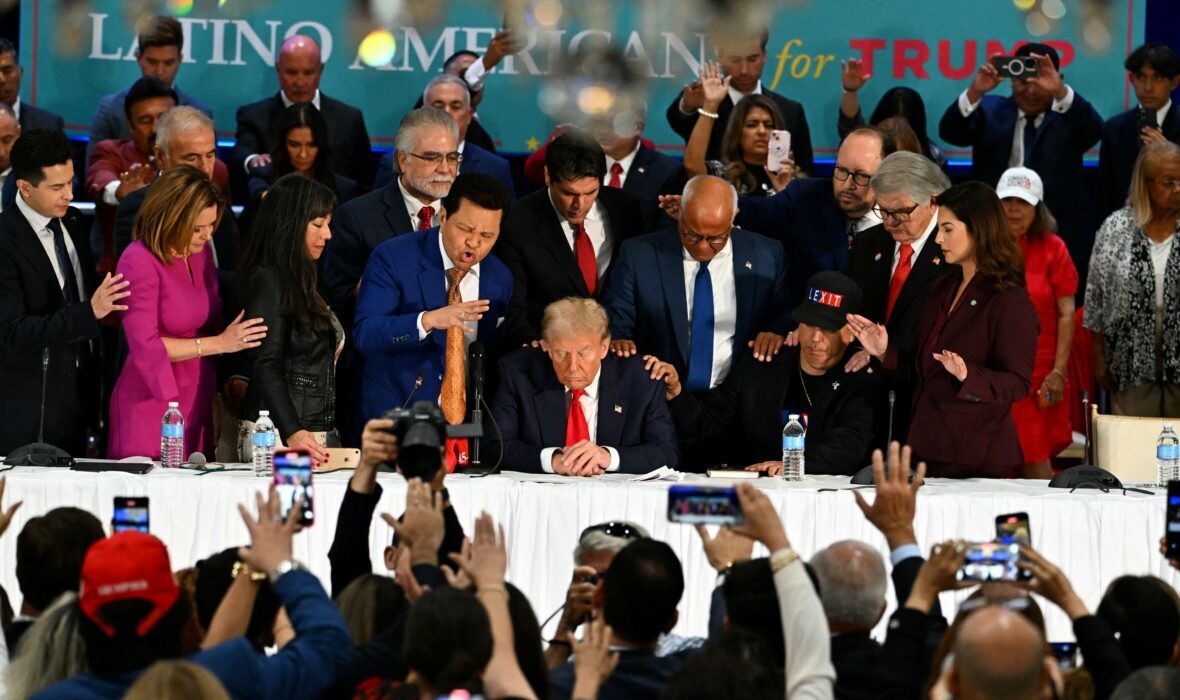The Delayed Democratic Majority
America is headed for one-party progressive rule.

Demographics are destiny.
That idea lay at the heart of the 2002 book The Emerging Democratic Majority, which argued that racial-demographic transformation, among other factors, was producing a political realignment that favored America’s Blue Team. The authors—John Judis and Ruy Teixeira—were pleased with their findings. All good liberals were.
The book freaked out Republicans and gave Democrats confidence that irreversible victory was possible, if not inevitable. As whites became a minority, many liberals believed, so too would Republican voters.
But then Donald Trump happened. His surprise defeat of Hillary Clinton in 2016 suggested that a “white lash” was wrecking Democrats’ hopes for one-party rule. Eight years later, Trump’s decisive reelection victory—winning all battleground states and gaining support from all racial minority groups—seemed to discredit the Judis-Teixeira theory more fundamentally. Smart Democrats pored over polling crosstabs and concluded they’d actually have to persuade voters if they wanted to win elections. Republicans, reassured that the browning of America didn’t mean the waning of their power, breathed sighs of relief.
So wide is the consensus that The Emerging Democratic Majority was wrong that even its authors have recanted. The book “laid out an overly optimistic forecast of the party’s prospects in an increasingly diverse America,” Judis wrote in 2017. This year, Judis warned his fellow liberals that Republicans may have the upper hand for the next decade. Judging by the national mood, Judis’s reversal seems warranted. The Democratic Party is demoralized and deeply unpopular. Republicans are exuberant. Everybody, apparently, thinks the GOP can continue stomping the DNC for many years to come.
This consensus view is mistaken. Absent significant changes to fertility rates and immigration patterns—changes that do not appear to be forthcoming—the Democrats are on track to achieve electoral dominance in the years ahead. The “emerging Democratic majority” hasn’t been disproven, but deferred.
Consider the 2024 presidential election. While many conservatives have hailed the “multiracial working-class movement” that Trump purportedly amassed, the great bulk of his voters—84 percent—were as white as the house he now occupies. That number is not far off from Mitt Romney’s 88 percent in 2012. Romney won whites by 20 points—a wider margin than any presidential candidate since Ronald Reagan—and many critics blamed his electoral loss on a failure to draw minority support. Yet Trump, whose voters were only moderately less white, has won praise for appealing to minorities.
The drop in the white share of the Republican vote does not indicate a surge in the GOP’s popularity among non-whites. Rather, it is mostly a function of the diminishing white percentage of the voting population, from 84 percent in 1980 to 66 percent in 2020. Thanks to high turnout from working-class whites, last year the white share of voters seems to have jumped for the first time since the early 1990s, though only by a few points. But as a share of the eligible electorate, whites have been in continuous decline. Non-whites accounted for an astounding 76 percent of the increase in the population of eligible voters from 2000 to 2018. Under Trump, Team Red is still very white compared to the overall electorate.
Kamala Harris, by contrast, assembled in 2024 an actual multiracial coalition. Her voters were 66 percent white, 18 percent black, 11 percent Hispanic, and 5 percent other. That’s more in line with the country’s demographics, which are changing rapidly. Americans under 18 became minority white in 2020, and the U.S. population is projected to do so by 2044. Less than a decade after that, around 2052, the electorate will become “majority-minority,” i.e., mostly non-white.
Republicans may struggle to win the White House starting several years before then, for a simple reason: While whites—unlike blacks, Hispanics, and Asians—lean Republican, they tend to be more evenly divided than other racial groups. In recent decades, college-educated white professionals have been more likely than working-class whites without a degree to vote Democratic, a split that has widened in the Trump era. Every time the GOP loses a presidential election, Republican strategists insist the party should focus on minority outreach, rather than on consolidating the white vote, and they see potential in a particular non-white group: Hispanics.
Much has been made of Trump’s gains among Hispanics in 2024, but Republican optimism (and Democratic anxieties) are overblown. According to a widely cited exit poll by Edison Research, Trump won 46 percent of Hispanics in 2024, two points more than George W. Bush did in 2004. Of course, 46 is close enough to 50 to raise hopes among Republicans, but caution is warranted.
A coalition of progressive nonprofits has contested the Edison number and sponsored a poll—conducted by Harvard University—that found that only 37 percent of Hispanics voted for Trump, far below 46. The true number is likely somewhere in between. AP VoteCast, a comprehensive survey of more than 120,000 voters, says that Trump garnered 43 percent of the Hispanic vote, which is consistent with polls from the final weeks of the campaign. That would be one point fewer than under Bush.
Excited talk of “increasing Hispanic support for Republicans” is exaggerated, if not outright false. The faulty impression arises not only from a fixation on one suspect poll, but also from the tendency of political analysts to compare Trump’s 2024 performance to 1) his dismal numbers among minorities in the two previous elections and 2) John McCain’s and Romney’s own dismal numbers against Barack Obama, whom non-whites found uniquely appealing. Last year, Trump didn’t bring together a historic and diverse coalition; he just brought the GOP back to its Bush numbers.
Indeed, Trump may have merely replicated the relative success among Hispanics of Ronald Reagan. “Reagan got as high as 47 percent of the Hispanic vote in one poll taken in 1984,” observed Judis and Teixeira in their book. That ABC News/Washington Post poll was an outlier—36 percent seems more likely—but Reagan undoubtedly made inroads into the Hispanic vote. Yet in subsequent elections, moderate Hispanics who had voted for the Gipper returned to the Democratic fold, for reasons that are well understood by political scientists.

Compared to blacks, who began bloc-voting for the Democratic Party during the civil rights era of the 1960s, Hispanics are driven less by identity and more by economic issues. They have favored the Democrats since 1972 if not earlier, but in elections taking place during times of economic trouble—including the inflation-ravaged Biden years—Hispanics flirt with the GOP if they prefer its candidate on the economy, as they did in 2024. Still, at least a slim majority still vote blue, and four years later, a fat majority will. Today, Hispanics seem likely to sustain the pattern in 2028. Since Trump’s inauguration in January, his approval rating among Hispanics has plummeted amid growing economic pessimism, dipping to the mid-30s.
In a message to me, Steve Sailer, the legendary socio-political commentator, compared Republicans’ glass-half-full view of Hispanics to a business joke: “Our prices are so low we lose money on each item we sell, but we make up for it on volume.” While Sailer acknowledged the possibility that a majority of Hispanic voters will back the GOP in future elections, he summed up the current situation thus: “If you used to lose 67–33 among some rapidly growing immigrant group and now you lose only 57–43, well, you’ve impressively blunted the bleeding, as it were, but the Great Replacement is still not working in your favor.”
How did Trump do among other minority groups in 2024? Not very well. Trump lost Asians by a margin of 15 points and blacks by 73, according to exit polls. That’s better than Trump, Romney, and McCain did previously but approximates what Bush achieved. Yes, Trump made gains among Asians and blacks—but he still got clobbered.
Given the persistence of racial gaps in voting, non-white immigration is set to put electoral victory beyond the reach of Republicans at the national level. Barring an unforeseen social transformation, another factor will compound the problem: fertility rates. Whites are making fewer babies than the national average, trailing far behind Hispanics and slightly behind blacks. Even if all immigration stopped today, the white share of the population would continue to decline.
Whites do have a higher fertility rate than Asians, who nonetheless have experienced the highest population growth among racial groups in recent decades, thanks to an immigration boom. Asians have had stiff competition: During the Trump years alone, from 2016 to 2024, the number of eligible Hispanic voters increased from 27 million to 36.
Trump deserves credit for twice winning the White House amid such adverse demographic circumstances, but both victories were exceedingly unlikely. In 2016, Trump became only the fifth presidential candidate in U.S. history to win the electoral college despite losing the popular vote. In 2024, he became the first Republican to win the popular vote in 20 years, though he still got less than 50 percent.
Moreover, neither of the candidates Trump defeated was particularly strong, to put it mildly. Harris was installed as candidate by party elites at the 11th hour. She then proceeded to run a bad campaign that overemphasized “saving democracy” at the expense of inflation and immigration, the problems that voters actually cared about. As vice president, Harris inherited the drawbacks but not the benefits of incumbency, since she was blamed for high prices and southern-border chaos but hadn’t gotten the chance to demonstrate presidential leadership.
Yet Harris almost eked out a victory. Incredibly, Trump won the popular vote by a smaller margin than did Hillary Clinton in 2016. True, he won all seven battleground states, but not by much, cracking 51 percent only in Arizona. Future Republican candidates will confront even stronger demographic headwinds than Trump did and probably will face more formidable opponents. The Arizona electorate, for example, will tip majority non-white around 2038.
What is to be done?
In 2000, Stever Sailer proposed an electoral strategy that has come to be associated with his name. Reacting to Bush’s popular-vote loss and slim electoral-college win, Sailer pushed back against the conventional wisdom that Republicans should reach out to Hispanics. The Sailer Strategy holds instead that the Republican Party should try winning even more whites, whom Sailer called “by far the dominant bloc in the U.S.”
Sailer was right. The main reason that the emergence of a lasting Democratic majority has been deferred is that working-class whites migrated to the GOP, against the expectations of Judis and Teixeira in 2002. But today, whites are a much less dominant share of the electorate than in the early 2000s, and in each of the 50 states, the bloc is only shrinking. Going forward, the GOP needs a qualified version of Sailer’s electoral game plan. Call it the “Smooth Sailer Strategy.”
The updated strategy still dictates that the GOP should prioritize candidates, policies, and rhetoric that appeal to whites. The difference is that, under the Smooth Sailer Strategy, overtures to whites should also attract winnable voters from one or more minority groups, or at least avoid repelling them without some compensating benefit. A push to eliminate all vestiges of affirmative action, for example, might galvanize whites and Asians, the groups that suffer from discriminatory policies. And since affirmative action is fairly unpopular even among blacks and Hispanics, it is an ideal policy for Republicans to make a bugaboo.
A GOP that implemented the Smooth Sailer Strategy could—and should—still advocate restricting immigration, as Sailer had recommended. Trump’s performance last year showed that the GOP can oppose mass migration—indeed, can even pass out rally signs that say “Mass Deportations Now!”—without scaring away immigrant groups. The GOP could try peeling conservative blacks away from the Democratic Party by emphasizing that illegal immigration lowers blacks’ wages. Tackling immigration would succeed not only at the level of campaign strategy, but also governance. In 2011, Sailer laid out the basics of a long-term Sailer Strategy for Republicans: “You want more of the kind of people likely to vote for your party in the country and fewer of the kind of people likely to vote for the other party.”
Of course, no one knows for sure how Hispanics and other minorities (or whites for that matter) will vote in the years and decades ahead. In the 1940s, George Orwell lambasted the mental tendency of James Burnham, a Trotskyite-turned-conservative, to predict “a continuation of the thing that is happening.” Republicans who expect to turn the GOP into a multiracial coalition might accuse my analysis in this essay of suffering from the same defect. Sure, minorities have historically favored the Democrats, but no iron law of politics dictates this must remain the case. The future is wide open! The sky is the limit!
Maybe. But Orwell’s admonition cuts both ways. No doubt, the 2024 election brought a redshift among Hispanics, and hopeful Republicans and panicked Democrats envision a continuation of the trend. On the other hand, non-white voters have favored the Democratic Party since the New Deal. Which of these things do you suppose is more likely to continue?
The post The Delayed Democratic Majority appeared first on The American Conservative.
.png)















 English (US)
English (US)